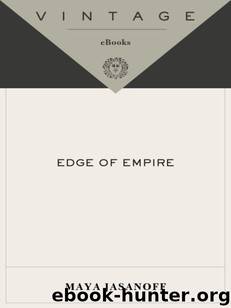Edge of Empire: Lives, Culture, and Conquest in the East, 1750-1850 by Maya Jasanoff

Author:Maya Jasanoff [Jasanoff, Maya]
Language: eng
Format: epub
Publisher: Knopf Doubleday Publishing Group
Published: 2007-12-18T04:30:00+00:00
III. From Kaveri to Nile
As visitors filed in by the hundreds to crank up Tipu’s Tiger in the India Museum, and as the Clives settled into Powis with their Indian things, Seringapatam objects underscored just how differently British rule in India was received and responded to after 1800 than it had been a generation earlier. Less than fifteen years before, Warren Hastings was spectacularly impeached for his ostensibly rapacious conduct as governor-general; fifteen years before that, Clive and his “Indian” peers were social pariahs. Now Indian objects and Indian money were incorporated, and even to an extent welcomed, in British public arenas. So was a militaristic approach to acquiring Indian territory, bolstered by the patriotic climate of the Napoleonic Wars. As a visitor to Richard Wellesley’s new Government House in Calcutta (completed in 1803) might see it, British imperial rule in India was a splendid and glittering thing. Modeled on Kedleston Hall in Derbyshire (built in the early 1760s by the Curzon family, one of whose scions would later become the most famous viceroy of India), Government House was a British stately home transplanted into the aromatic greenery of the tropics: a gleaming white Palladian palace, flanked by cannons and lions, filled with rich polished marble and neoclassical busts of British imperial grandees. Mirrors and girandoles bought from Claude Martin’s Lucknow estate were installed in its halls.66
By no means, of course, did the Revolutionary-Napoleonic Wars or the wave of conquests in India mean that direct imperial rule was unanimously embraced in Britain. One source of mistrust came from the East India Company directors themselves, who recalled Wellesley in 1805 for his costly campaigns (and costly Government House), to say nothing of his overbearing style. Yet even they would have acknowledged that the nature of Britain’s empire in India was changing in fundamental ways. There was the simple fact of its territorial expansion. By 1801, the East India Company had absorbed Mysore, Hyderabad, and Awadh into formal or informal control. Hard-won victories over the Marathas between 1803 and 1805 asserted British power in the face of another mighty “Francophile” indigenous opponent. With the Maratha Wars of 1817–1818, the confederacy was defeated and British dominance extended to the borders of the Punjab. Another sign of change was the way such conquests were received. Where parliamentary challenges to Clive and Hastings had once put East India Company rule itself on trial, now (and partly in consequence of those controversies) the British government was increasingly involved in administering Indian domains. Parliament supervised Company affairs through the Board of Control, and more than twenty thousand Crown troops were stationed in India, alongside the two hundred thousand–strong army of the East India Company.67 Wellesley’s recall was due not so much to British wariness about rule in India as to Company concern over its balance sheets. If anything, Britons with no personal investment in empire were probably more enthusiastic about territorial expansion than Company shareholders.
The capture of Seringapatam and its material impact on British culture made two transitions manifest: the turn to open conquest, and heightened public involvement in it.
Download
This site does not store any files on its server. We only index and link to content provided by other sites. Please contact the content providers to delete copyright contents if any and email us, we'll remove relevant links or contents immediately.
| Africa | Americas |
| Arctic & Antarctica | Asia |
| Australia & Oceania | Europe |
| Middle East | Russia |
| United States | World |
| Ancient Civilizations | Military |
| Historical Study & Educational Resources |
Room 212 by Kate Stewart(4991)
The Crown by Robert Lacey(4704)
Endurance: Shackleton's Incredible Voyage by Alfred Lansing(4649)
The Iron Duke by The Iron Duke(4266)
The Rape of Nanking by Iris Chang(4118)
Joan of Arc by Mary Gordon(3998)
Killing England by Bill O'Reilly(3936)
Say Nothing by Patrick Radden Keefe(3864)
I'll Give You the Sun by Jandy Nelson(3338)
Shadow of Night by Deborah Harkness(3272)
Hitler's Monsters by Eric Kurlander(3252)
Mary, Queen of Scots, and the Murder of Lord Darnley by Alison Weir(3128)
Blood and Sand by Alex Von Tunzelmann(3113)
Darkest Hour by Anthony McCarten(3052)
Eleanor & Park by Rainbow Rowell(3026)
Margaret Thatcher: The Autobiography by Thatcher Margaret(3016)
Red Famine: Stalin's War on Ukraine by Anne Applebaum(2854)
Book of Life by Deborah Harkness(2847)
The One Memory of Flora Banks by Emily Barr(2770)
